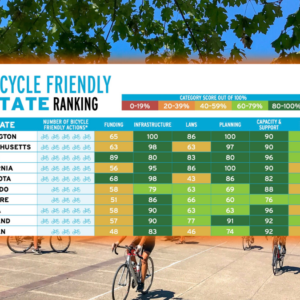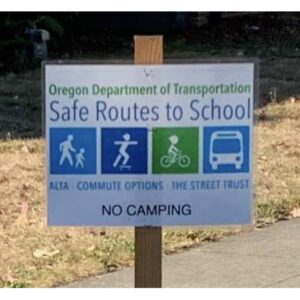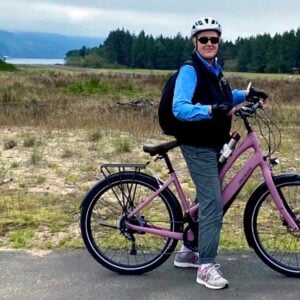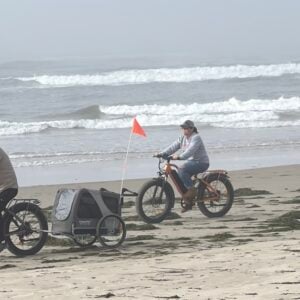
WA, WI, ME and MN.
The League of American Bicyclists has released rankings for their Bicycle Friendly States program. Oregon earned the fifth spot this year, slipping from the fourth spot we’ve held the previous two years. For the third year in a row, Washington retained the top spot with Wisconsin coming in second.
Moving up to take fourth place away from Oregon this year was Minnesota — home to Minneapolis, the city that unseated Portland from the top spot in a recent list of bike friendly cities by Bicycling Magazine.
Here are the top five:
“The reasoning for Oregon dropping below Minnesota is simply that Minnesota is performing better this year.”
— Meghan Cahill, League of American Bicyclists
- 1. Washington
2. Wisconsin
3. Maine
4. Minnesota
5. Oregon
And the bottom:
- 46. New Mexico
47. West Virginia
48. Montana
49. North Dakota
50. Alabama
The rankings are based on a 95-item questionnaire that covers six areas: legislation, policies and programs, infrastructure, education and encouragement, evaluation and planning, and enforcement. To keep the rankings consistent and allow states to track their progress, the League keeps all the questions and methodology consistent each year.
Oregon’s ranking has improved significantly in all categories. In the past we scored low on Legislation (27th in 2008) and Planning (18th in 2008). This year, the League ranked Oregon in the top ten in four of the six categories. Our lowest ranking came in Infrastructure where we ranked 21st.
I asked the League’s director of communications Meghan Cahill why Oregon dropped to fifth. While she lauded our vulnerable roadway user law and Scenic Bikeway Program, she said, “The reasoning for Oregon dropping below Minnesota is simply that Minnesota is performing better this year. Oregon hasn’t been spending available federal funds that can be used for bicycling related projects as well as they could, and Oregon rescinded quite a bit of the federal money – more than was required by FHWA.”
The “rescinded” funds Cahill refers to above are funds that have been given to state DOTs (for programs like Transportation Enhancements (TE) that are a major funding source for active transportation projects) by the federal government but are sent back without being used.
According to analysis by advocacy group America Bikes, Oregon sent back $20.2 million to the Federal Highway Administration in 2009 in unspent funds slated for three active transportation programs (TE, the Congestion Mitigation and Air Quality grant program, and the Recreational Trails Program).
Why on earth would ODOT give back money to the feds? Pat Fisher, ODOT’s TE program manager says it’s not that simple.
I spoke with Fisher yesterday about the League’s criticisms and she said she’s frustrated by what she feels is a mischaracterization of a complicated issue:
“Recissions are very misundertood… Those dollars are not really accessible dollars… In reality that’s money that’s from clear back in the mid 90s. In order to award the money to some project now, you’d have to take another project out of the STIP [State Transportation Improvement Program] You’d have to argue that another project is going to be delayed because we want to go back and use the old TE money… Theoretically you could, but politically it’s just not going to happen.”
Fisher added that the rescinded money is often simply the difference between what Congress appropriates and what is then actually authorized to states. “It never got into the bank account to begin with.” She also said that much of the rescinded amount is not ODOT’s fault because even if they award money to counties and cities, if those agencies and jurisdictions don’t do their projects, the money is never spent (and therefore gets sent back).
Regardless of what played into these rankings, I don’t like being in 5th place. If this ranking gets under your skin (like it does mine), you can help Oregon become the best biking state in the country by joining us for the fifth annual Oregon Bike Summit on June 4th. We can’t be satisfied with fifth place! Come to the Summit and help us strategize and mobilize to reach #1.
(Get your big ideas together for how to make Oregon the #1 bike state… BikePortland will be hosting a contest for the best one. Stay tuned for details…)







Thanks for reading.
BikePortland has served this community with independent community journalism since 2005. We rely on subscriptions from readers like you to survive. Your financial support is vital in keeping this valuable resource alive and well.
Please subscribe today to strengthen and expand our work.
Hmm. #5 Bikey, #6 Homeless. Plus our Food Stamp program has one of the highest enrollment rates in the country. There are certainly regional rankings that should be cause for concern. But I wonder if being the #1 bikey-town is worth being #1 in hunger and homelessness?
I wonder if Oregon has become for cycling states what the Yankees are to baseball, meaning that people are sick of us – especially since a lot of the higher-ups here have grown so complacent.
That’s it. I’m never riding my bike again.
I’m getting to know vance pretty well.
Looking at the BFS application, it seems the program is exclusively directed at state DOTs, and doesn’t consider the activities of cities within. (There are some questions where cities come into play, but not very many).
I’d like Oregon to be #1 in the BFS program, but if there were a composite ranking incorporating both the BFS and the Bicycle Friendly Communities rankings, Oregon would probably move up near a first place tie with Washington.
Look at the Bicycle Friendly Communities in the top 5 Bicycle Friendly States:
#1 BFS. Washington
Platinum (0)
Gold (1): Seattle
Silver (2): Olympia, Bellingham
Bronze (4): Vancouver, Spokane, Port Townsend, Bainbridge Island
#2 BFS. Wisconsin
Platinum (0)
Gold (1): Madison
Silver (0)
Bronze (1): Milwaukee
#3 BFS. Maine
Platinum (0)
Gold (0)
Silver (0)
Bronze (1): Brunswick
#4 BFS. Minnesota
Platinum (0)
Gold (0)
Silver (1): Minneapolis
Bronze (1): Rochester
#5 BFS. Oregon
Platinum (1): Portland
Gold (2): Corvallis, Eugene
Silver (1): Bend
Bronze (4): Salem, Albany, Ashland, Beaverton
Looking at the other end of the rankings, I was in Alabama (#50) a couple of weeks ago. In five days time I saw exactly one cyclist and he was on the sidewalk. Based on conditions, I’m not sure I would have ridden any differently than he did.
We have it pretty good out here.
Let me add that I agree this should put some pressure on ODOT to step things up a bit, even though I make the case that in terms of comprehensive bike friendliness, Oregon is still at the top.
But I would guess that most people wouldn’t intuitively make the distinction between state and their cities within when looking at a “state” ranking… perhaps the League should make this more clear when promoting the BFS program. While BikePortland readers may figure it out, some less investigative types (KATU journalists, anyone?) may miss the point.
those are great points Elliot. thanks for making them.
The reality is that it’s impossible for the League to truly do the full analysis required to make a definitive ranking of anything. They do a good job — MUCH more thorough than Bicycling Magazine — but it’s still very lacking.
And asking the state DOTs makes sense… but they are notorious for being understaffed when it comes to working on non-motorized projects.
friendly? there were complete a-holes on 2 wheels out this morning in force…how people think it’s safe to blow 2-way stop sign intersections without even looking right I will never understand…..makes me wish for a good rain storm…
I still have Hope for Wilsonville, for my girls then again we have I-5 coming right into us. along with massive side street traffic.
wait Hope for all to see what cycling bring to a City,if its not safe people re-think riding.
It looks like they are just rating the bureaucracy. How about the actual riding? Rural Oregon roads are so ridiculously narrow that it’s almost scary to get out and ride. Look at Stafford Road. Look at Skyline. Nothing more than paved goat paths. Yea, the rides are scenic (if you ignore all of the garbage in the ditches) but having numerous close calls with vehicles kills the mood of the ride.
I really appreciate your coverage of some of the finer nuances of federal funding. I work in the public sector and boy am I aware of how hard it is to explain the byzantine regulations–especially those involving federal dollars–that govern the getting and spending of money.
Jonathan is correct in that it is difficult to create a ranking system that captures everything that goes into making a state bike-friendly or not. What we have done is create a list of items based on proven best practices and items the League and other advocates have worked for on the state level. Slipping in the ranking shouldn’t be a sign that Oregon is falling down, but rather other states, such as Minnesota, who had previously been following your lead are now moving ahead on the items we measure. Many advocates are using this ranking as a tool to push their state to improve. Hopefully the drop opens up an opportunity to talk about improvements needed in Oregon. As Jonathan stated, the Oregon Bike Summit is a great opportunity to do that.
Every state has areas in which they could do better. Despite some fantastic riding in the state, Oregon is falling behind other states in our Infrastructure category, which covers federal funding obligation rates and rescissions. I’m sure advocates across Oregon would like to see transportation dollars that are available for bike projects more fully utilized. Rescissions and the federal funding process is, as was said, a very complicated subject and I won’t get into the details in the comments section. Interested readers and advocates should review the League’s reports on some of the key bike/ped funding sources (CMAQ, HSIP, Section 402). See the list of items here: http://www.bikeleague.org/resources/reports/. Of particular relevance to this discussion is rescissions: http://www.bikeleague.org/resources/reports/pdfs/rescissions_restoration_april_2010.pdf.
Despite dropping a notch in the ranking, it’s not all bad news. Oregon also received a Silver Level Bicycle Friendly State award. In addition to answering the ranking questionnaire, coordinators can respond to the additional application that covers more of the items others have mentioned. With Oregon’s Scenic Bikeway program and other model bicycle tourism efforts; vulnerable user law; urban highway context sensitive design guidance; bike accommodation policy dating back to 1971; etc. etc. the state still is a national leader for bicycling and should be celebrated.
What is Washington doing that is so great ? Twould be nice to know.
In ten years will Oregon fall down near Alabama (or Alabama rise again?)
Will BikePortland become BikeWashington? Nah…but…
There could be some truth in your thinking that folks are tired of the ‘Oregon’ story…it is a good one but not as great as it once was especially with creative competition…like when Pentalosa came to town during the carfree conference and told Portlanders that #1 (bikeable community) is good…but it all depends who your are ranking against…the kiddie league or the world cup league.
Jeff, could you comment on how some other states made such big leaps from 2009 to 2010? (Florida and Kansas +20, Tennessee +19). I’m curious how they did it.
Also, the “Click here to read more” link on the BFS page currently leads to the 2009 press release – maybe the 2010 press release already answers my question?
Understanding ODOT is hard, and I like Steve Duin’s joke about waiting for G’odot.
ODOT Region 1 is not like the rest of the regions, and the progress you’ve made in region 1 isn’t extended through the other regions consistently.
Here in region 2 we struggle a lot – maybe best encapsulated by the fact that the Union St. Railroad Bridge, now a bike/ped only facility, is bounded by two state highways that ODOT has no apparent interest in helping us cross. So it’s a bit of a bridge to nowhere just now.
Navigating the STIP, reassessing high-level priorities and values, and moving around larger pots of money to instantiate those values (instead of the proverbial begging for table scraps) should be a project on advocates plates. I think Susan Peithman & Doug Parrow are devoting increasing attention to the Oregon Transportation Commission. Sheila Lyons and Pat Fisher deserve more attention, budget, and institutional heft!
This is a long of of saying that maybe the rankings and Oregon’s fall is merited more than not.
Don’t worry at all about these rankings. Vermont has always been a very friendly bike state, it’s ranked 34. Florida is ranked 12 and felt a lot scarier. Oregon and Washington are really the best, I think.
Jonathan (#8) – That may be true, but they make no effort to look at the county level, or to incorporate local jurisdiction data that they already have from their other programs. Also, their application has some interesting and frankly, ridiculous questions. “Does your state have any numbered bike routes?” “If so, do you have a plan and funds to maintain them?” – US Numbered bike routes are an arbitrary program promoted by the Adventure Cycling Association, not a governmental program. The routes are where ACA placed them in 1982.
These are valid issues when the ranking are viewed as authoritative and having weight, which arguably, they are and do.
I’d like to see an effort to determine what support counties provide to bikes, as county governments typically control a large area of the state and the majority of low-traffic statewide routes.
Also, if the League would like to promote the concept that the ranking change reflects some states getting better, they would be wise to add a metric showing this – i.e. a “total points” score of some sort.
The statewide score is really just a rating of the regulatory environment and legal framework, and it can be argued that the most common scenario where that even matters is after you’ve been struck or intimidated by another vehicle.
I think it’s a great call for action, but I’d hesitate before ascribing more meaning to the statistic than is even there. Rather than worrying about who we’re better than, perhaps the focus on all levels should be to facilitate travel via all modes as safely as practicable, and as equitably as possible, so that parents feel safe letting their kids walk or bike to school, and elderly can enjoy a walk or ride through their own neighborhood without fear of injury or intimidation.
it seems so weird that it only takes one good bicycling city to get a state in the top rankings…
Elliot #5, thanks for breaking down the cities in each state, it’s a better measure when thinking locally…
Oregon:
Idaho’s Portugal
soooo… perhaps it’s time portlanders take notice of us folks in vancouver. evidently we are doing something right up here. todd boulanger and jennifer campos both deserve a heart felt thanks for all their work. kudos.
they missed Florida, it should be in the bottom 5.
Why Florida should be ranked much lower: http://www.bikeradar.com/news/article/cycling-fatalities-highest-in-florida-25385
I had a bike stolen in Brunswick, ME once.
I had a bike stolen in Seattle too, but I found the one in Brunswick and left the new owner a nasty note…
I’m just sayin’
The fact Washington tops the list makes me wonder if anyone making the list has tried riding in one of their impossibly narrow 4 foot bike lanes (which as often as not gets rounded down to 2 or 3) or Clark County drivers…
Re: #19 —
Matt,
The U.S. Bicycle Routes to which you refer are not arbitrary and not designated by Adventure Cycling. They are part of a fast-growing new project called the (official) U.S. Bicycle Route System. This is a partnership between public agencies, advocates, and others, including organizations like Cycle Oregon. For more information, go here:
http://www.adventurecycling.org/usbrs
From #48 Montana,
Jim Sayer
Adventure Cycling Association
*I* lived and rode in Maine for 7 years. The authors of this list steadfastly ignored input from actual riders and previous residents of states such as Maine, including myself.
Oregon does belong in the top 5 as surely as Maine belongs in the bottom 10. Is there room for improvement? Always, but don’t get worked up about these twits and don’t support them. They are merely bureaucracy in action.
What’s the big deal? This is no different than any other list. Any given year Portland is “The Best City in America”, “Most Awesome Place to Raise Kids”, “The Most Depressed Town in the USA”, “The Ugliest Singles”, “Best Pan-Asian Food Scene”, etc. It really doesn’t matter as these lists are purely subjective and largely irrelevant. Heck, ask all those eager new emigres that moved here thanks to “The Best City in America 2007” hype and find themselves unemployed and struggling whilst their friends back in Omaha or Poughkeepsie are buying homes and pulling good paychecks.
Do you like it here? Then stay and make things better.